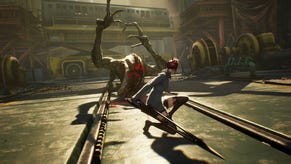Stellar Blade brings old-school console sensibilities to PS5 - with a modern flourish
A highly polished, bug-free experience.
First shown nearly three years ago under the name Project Eve, the Korean developed Stellar Blade has finally arrived and for me delivers an experience that feels like a proper, complete, polished console game. You see, in this age of incomplete games, buggy launches, and countless promises buried in patch notes, Stellar Blade launches in an impressively complete state. This is an impeccable, gorgeous, and fun action game that perfectly balances modern sensibilities with design elements that would feel right at home on the PlayStation 2 - and that's a good thing.
Going into this one, it's fair to say that many of us were sceptical when Stellar Blade was first revealed. While the game was getting a lot of attention for its main character, there were a lot of questions surrounding the game - its developer, Shift Up, for example, had never made a large-scale console experience, focusing instead on mobile games. Furthermore, the various pre-release media showed unstable performance, leading us to wonder how the final game might perform.
The good news is that the final product is a cohesive experience that harkens back to a time when Sony Computer Entertainment would publish games across a wide range of genres - the PlayStation and PS2 era were packed with first-party published games developed by partner studios that played in so many different genres and themes. That's exactly where Stellar Blade sits. In a sense, it feels like a game from 2002 built using modern technology and design elements. It's not another sequel or remaster - it's a highly enjoyable game.
Part of this stems from its impressive level of polish. Shift Up has taken a slightly conventional approach to the visual design that works to their advantage, creating something that plays like a console game should. The game is built using Unreal Engine 4, not pushing any technical boundaries, but at the same time, offers players a completely fluid, stable and attractive game that feels complete and polished on day one.
It starts right from the main menu - a ruined earth looms in the background as you configure your preferences. When you finally press that new game button, the scene seamlessly springs to life. There are no loading screens or fades to black - it simply begins - just like that. I'm always a sucker for seamless menu to game transitions and Stellar Blade delivers. By the time you reach the surface, and everything on the mission has gone wrong, the camera pulls up behind Eve and the player is handed control. This initial sequence is impressive to behold with explosions rocking the scene as you rush ahead and begin to unleash strings of combos.
You can simply begin to play from this point but as has become a habit, I dipped back into the options menu to explore the various settings on offer. I was slightly disappointed to see the game lacks a toggle for film grain - while it looks OK to my eyes, not everyone likes film grain in their games and it makes video production more challenging. Motion blur is, at least, fully adjustable, as is camera shake. Furthermore, Stellar Blade does support HDR but it has one caveat to keep in mind - the game does not take into account the PS5 system level HDR calibration, so you need to adjust these settings carefully to match your set. In my case, I found that boosting the brightness slider combined with a slight increase in contrast produces a nice image but your mileage may vary.
Once you've settled into the game and begin playing, take a moment to look around. Stellar Blade takes place across a ruined earth far in the future - there's little doubt that you'll be reminded of the Nier series yet it still feels compelling on its own. This is a game that leans heavily on its art design. The urban ruins are reasonably detailed with debris and crumbling structures often filling your view but it's the actual art direction that stands out. This is a good lesson in leveraging design without pushing technical boundaries to reach a target level of performance. As a UE4 game, Stellar Blade uses all the typical features - the volumetrics, the approach to baked lighting, the entire post-processing suite and more. Compared to some of the highest-end UE4 titles, such as Jedi Survivor, you won't see any sort of advanced ray tracing features or visual flourishes along those lines.
Instead, the team focuses on performance. Stellar Blade manages to avoid stutters and hiccups almost completely. Furthermore, it loads extremely quickly and the frame-rate is nearly perfect within the bounds of each of its graphics modes. My experience has also been remarkably free of bugs or unexpected behaviour. To me, this demonstrates an impressive level of restraint in pursuit of the best player experience.
That's not to say there aren't visual flourishes to appreciate - the character models, for instance, are very well done with dense meshes boasting a nice blend of materials both for skin and outfits. This gels with the animation work that ensures characters look and feel great while fighting through the hordes. The one caveat is how thin objects, such as hair, can appear somewhat noisy at times with visible breakup. The physics applied to the hair are neat, at least, but it's nice that a shorter hair option is available for those distracted by the shimmer and noise.
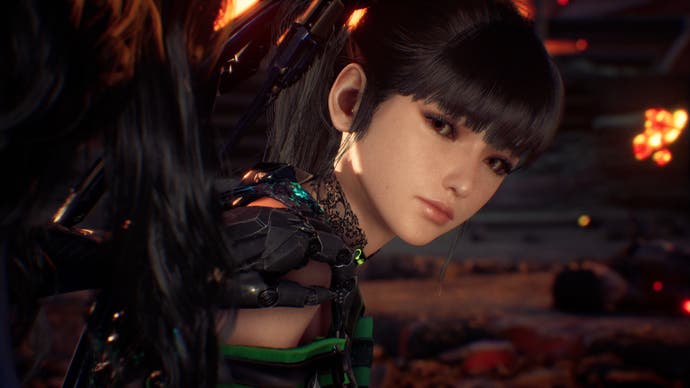
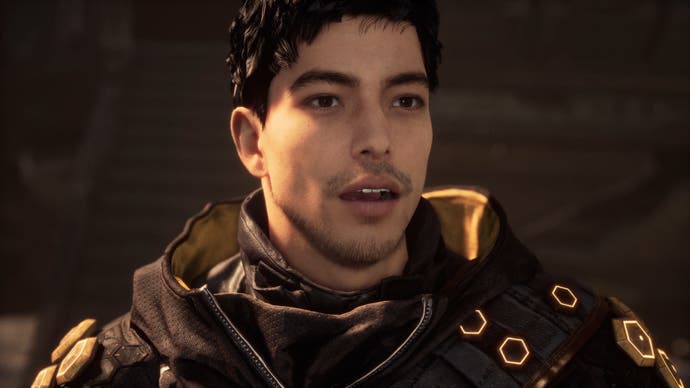
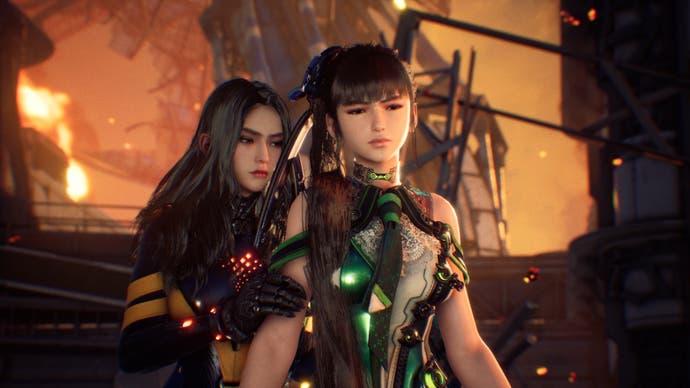

I'm also a fan of enemy designs and animation - especially the bosses. You'll face off against some truly outrageous designs that offer up a steep challenge. It's often difficult to parse what you're looking at which only amps up that sense of intrigue. The animations are superb and enhanced by per-object motion blur. Really great stuff.
The environment itself is also large in scope and reasonably detailed but the restraint on display doesn't always yield great results. On the positive side, the structures populating the world along with the actual layouts feel properly post-apocalyptic in design. It's not just limited to vistas of ruined cities either. Each of the game's maps are also extremely large yet decidedly not 'open world' in the traditional sense - it features proper pathing, obstacles, and shortcuts to uncover.
When I say that Shift Up has taken a conservative approach to visuals, however, this is most visible in these environments. Elements like reflections and certain shadows are handled primarily in screen-space, for instance, while textures can appear blurry and low resolution at times especially in close-ups - like Final Fantasy 7 Rebirth, curiously enough. Furthermore, Stellar Blade seems to use standard Unreal Engine baked lighting which means areas without a direct light source often lack nuance without convincing indirect lighting.
Then there's image quality. Essentially, there are three modes - one that favours performance, another that favors resolution and one that attempts to strike a balance. Quality mode aims for native 4K and usually manages this with some dynamic resolution scaling evident from time to time but this mode drops the frame-rate to 30fps. Performance mode, however, delivers a 1440p presentation that also manages to stick relatively close to the target. Both seem to use a basic spatial upscaling method. The balanced mode is more interesting though, in that the resolution is technically lower ranging between 1080p and 1440p most of the time, yet this one seems to use temporal upscaling via reconstruction. As a result, image quality can sometimes exceed the native 4K option. Beyond image quality, however, no other visual differences are evident.
Each of these modes have a very specific use case that varies based on your TV, to some degree. Performance mode is perhaps most impressive in that it delivers a rock solid 60 frames per second almost all of the time. Even when things heat up, the frame-rate very rarely hiccups. The only time I detected slowdown was during very specific cutscenes and even then, it's very brief. I really have to praise Shift Up for the work they did on performance because locking this down to a stable 60 fps without hiccups and stuttering is really commendable.
Quality mode, simply targets 30fps and, in my opinion, is the least interesting mode. The game plays worse at 30fps and, frankly, isn't worth using when you have the option for 60. It is at least properly frame paced and very stable, so that's something. Balanced mode, however, is very interesting - it targets 60fps and is often very stable indeed, like performance mode, but this one can exhibit drops. The key here is that these drops, almost universally, manage to stay above 50fps, meaning the game sits comfortably within the 48-60 fps VRR window of PlayStation 5. As a result, this feels like a mode designed for VRR displays and is the mode I'd suggest if you're using such a monitor. The dips in performance are mostly undetectable with VRR engaged.
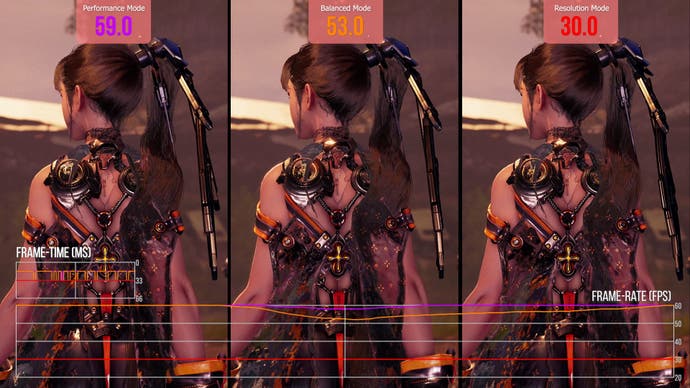
The reason I like this so much is that the developers did not skimp out on a proper, locked 60fps mode. Rather, balanced is simply a bonus option for VRR users that produces slightly better image quality. It's still pretty good without VRR, but less so - it varies per area. The desert, for instance, is mostly a locked 60 in balanced mode. This is a perfect example of how to do performance modes in a console game. Shift Up nailed this, exceeding most Unreal Engine games I've played this gen. Well done.
There's more to this game, though. I mentioned earlier that it reminds me of the early 2000s when games often attempted ideas that may or may not work out perfectly but added flavour to the overall experience. For instance, there's one point where you infiltrate an abandoned underground laboratory - you're unable to wield your blade in this location forcing the player to shift strategies relying exclusively on your drone cannon. Along the way, there were random elements such as dodging debris while trying to shut down a large ventilation fan or another section where lasers suddenly block you in forcing you to deal with incoming foes. This whole sequence plays unlike anything else you'd experienced up to this point and I loved it.
To that end, while Stellar Blade does have elements of modern From Software titles and, of course, Nier Automata, it also reminds me more of Team Ninja's seminal Ninja Gaiden - at least in terms of structure. No, the combat system is not on that level, but the way the map is built, the progression through the game and the random set-pieces that rely on different mechanics really remind me of my first time going through that original Xbox masterpiece.
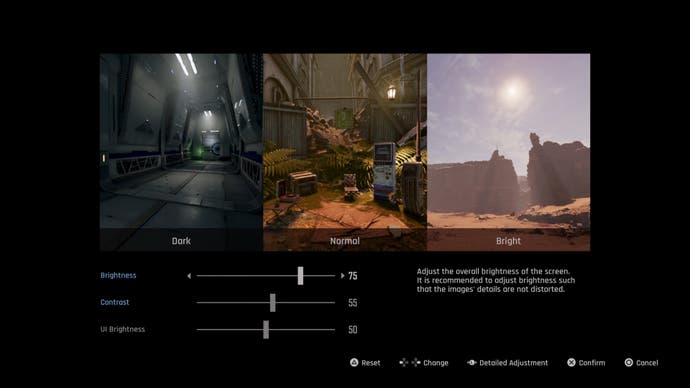
I was genuinely surprised by how well put together and paced this game really is. You'll want to keep pushing forward to see more of the world and deal with new, unexpected challenges. All of this is enhanced greatly by a superb audio presentation - mostly. The actual production work is awesome. The soundscape, sound effects and voice acting are all top notch. The game includes multiple languages for voiceover including what I presume to be the original Korean, which is nice. More importantly, the soundtrack is simply superb and adds a lot to the experience.
However, there is one audio critique I wanted to mention - surround sound. Firstly, with Dolby Atmos selected at the system level and the AVR receiving the signal, the game only wants to output in stereo, which is not the case for other games that I've tested. Switching to Linear PCM solves this but then highlights that the surround mix, perhaps, goes a little too heavy on the rear channels with a lot of sound and music playing behind you. So, in that sense, I feel the surround experience could use some additional work.
Input latency is a topic that was raised when the demo released and it's true, there does appear to be a slight delay in certain actions, but after playing it for countless hours, I found that I become accustomed to it and it feels like an intentional part of the design. I recommend trying to get used to the demo and see if it suits you. Beyond that, a brand-new game that echoes some of the design choices and experimentation of a bygone era, combined with excellent visuals and a brilliant level of polish makes Stellar Blade a winner - and I highly recommend it.






